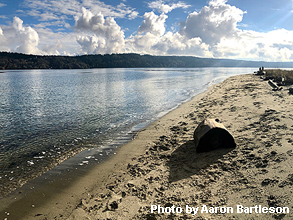This ordinance affects Kitsap businesses and was adopted in 2022. The ordinance went into effect August 1, 2022. It is also referred to as the "Source Control BMP Ordinance." A BMP is a Best Management Practice.
About the Ordinance
Kitsap County is building a program that requires businesses take measures to stop water pollution before it enters the stormwater system. This is mandated by Department of Ecology’s Western Washington Phase II Municipal Stormwater Permit.
The Department of Ecology's mandate requires businesses to address pollutants such as fertilizers, oil and grease, washwater, etc., that originate from daily business/site activities, spill incidents, improper disposal, or other indirect sources by implementing Best Management Practices (called BMPs for short).
Polluted runoff from local businesses negatively impacts salmon, orcas, and other wildlife that depend on clean water in Puget Sound, lakes and streams. By stopping pollutants at the source, businesses can make a significant impact in preventing water pollution.
Who does this ordinance affect?
All pollution generating businesses operating within unincorporated Kitsap County are required to follow the ordinance. Examples of business that are required to implement BMPs include, but are not limited to:
- Automotive bodywork and repair
- Mobile businesses
- Gas stations
- Food service establishments
- Dry cleaners
- Grocery stores
- Businesses with fleet vehicles
If your business is located within the city limits of Bainbridge Island, Bremerton, Port Orchard or Poulsbo, refer to that city's code for their specific ordinance.
When will the ordinance take effect?
The ordinance took effect August 1, 2022.
What is the ordinance language?
Kitsap County Code Title 12 Stormwater Drainage
Chapter 12.20.030 Source control of existing development
The ordinances states:
All pollution generating sources associated with existing land uses and activities, as defined in the Western Washington Phase II Municipal Stormwater Permit, must implement applicable operational source control BMPs as specified in the Ecology Manual in order to prevent pollutants from entering the County's stormwater drainage system. Should applicable operational source control BMPs fail to prevent illicit discharges or allow violations of surface, groundwater, or sediment management standards, applicable structural source control BMPs or applicable treatment BMPs shall be implemented. In cases where the manual(s) lack guidance for a specific source of pollutants, the County shall work with the owner/operator to implement or adapt BMPs based on the best professional judgement of the County.
What is stormwater?
When it rains or snows, water flows over hard surfaces such as roofs, streets, sidewalks. As the runoff travels to storm drains, ditches and pipes, it picks up pollutants along the way from metals, gasoline, sediment, pathogens and nutrients. Surface and stormwater runoff is the leading transporter of pollution into Puget Sound and our local creeks and streams.
What are Source Control BMPs?
A business is considered the potential "source" of pollutants. Source control means the control of pollutants from entering storm and surface water.
Source control Best Management Practices (BMPs) are actions you can take in your business to help prevent or reduce pollutants from entering the stormwater system and polluting surface or ground water. There are three types of BMPs: operational, structural and treatment.
Operational BMPs are required of all pollutant generating businesses under this proposed ordinance. Common operational BMPs could include:
- Sweeping
- Labeling chemical containers with contents
- Good housekeeping and spill prevention (spill kits, training)
- Properly storing chemicals
- Correctly disposing of wash water
- Keeping dumpster lids closed and area free of trash
- Correct disposal of hazardous waste
When operational BMPs are not effective, structural BMPs may be required. Common structural BMPs include:
- Berms
- Plastic sheeting
- Oil/water separator
- Herbicide/pesticide storage in a covered, dry container
- Spill containment sump
- Covering over dumpster enclosures
- Paving
When structural BMPs are not effective, treatment BMPs may be required. Common treatment BMPs include:
- Biofiltration swales
- Filter strips
- Conveyance of high potential oil spill areas to be directed to sanitary sewer, with an oil/water separator for pre-treatment

